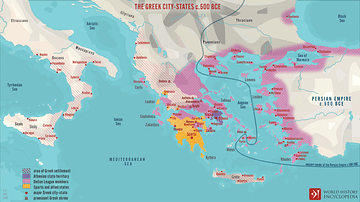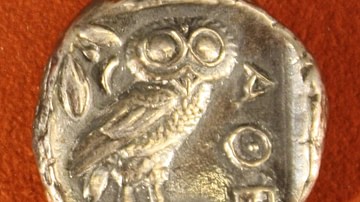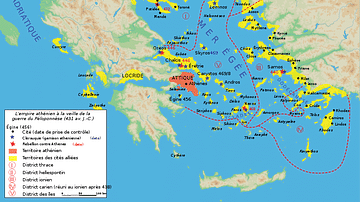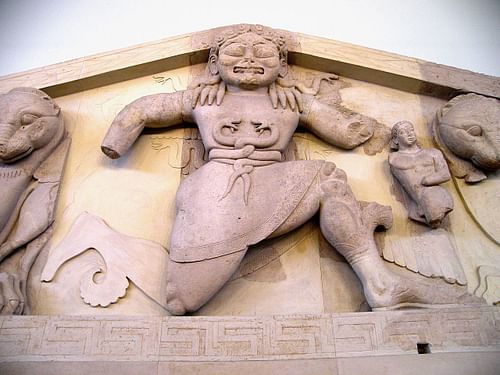
Corcyra (modern Corfu and also known as Kerkyra) located in the Ionian sea is one of the northern most Greek islands and was an important polis or city-state in the Archaic and Classical periods. Possessing a significant naval fleet and controlling access to the Adriatic, the island was often fought over by larger city-states such as Corinth and Athens in the Classical Period and was a Roman naval base in the 1st century BCE.
Archaic & Classical Periods
The island was first inhabited in the Neolithic age and early Bronze Age archaeological remains show similarities with finds in Campania and Apulia (central and southern Italy). Strategically positioned to control the early sea routes between Greece, Italy and the wider Adriatic, the island became a significant port. In the 8th century BCE, by driving out the Eretrians a colony was established by Corinth on a rocky peninsula on the east side of the island; the traditional date for this historic founding was 734 BCE. The city gained the name of Corcyra and thanks to its three harbours prospered as a trading centre. The name Corcyra may be a corruption of 'Gorgon' - after the mythical creature known as Medusa who was killed by the Corinthian hero Bellerophon.
Relations between the native population and the colonising Corinthians were initially cooperative with colonies at Epidamnus and Apollonia being co-founded between the two but Corinth would have its hands full to contain the island in the longer term. According to Thucydides, in c. 660 BCE the two fought in a sea battle with Corcyra victorious. The Corinthian tyrant Periander brought the island once again in line with the mother city but on his death the island once again fought for independence. Corcyra then followed an isolationist policy, rarely interfering in wider Mediterranean affairs and, significantly, refrained from participating in the Persian Wars of the early 5th century BCE which involved most of Greece. The island was helped in this independent stance by its high degree of self-sufficiency. The favourable climate of the island (having one of the highest rainfalls in Greece) allowed agriculture to prosper so that even the export of surplus goods, particularly wine, was possible.
However, a civil war at Epidamnus once again brought a head-on conflict with Corinth and the island allied itself with Athens, who was eager to protect her trade routes. In 433 BCE the Athenians sent a small fleet in assistance against Corinthian naval interference, a force which was reinforced in 427 and 425 BCE. The civil war (stasis) of 427 BCE in Corcyra was particularly bitter, with two main factions - democratic and oligarchic - committing atrocities and the citizens of Corcyra, thereafter, gained a reputation for being quarrelsome independents. In 410 BCE the democratic faction sought support once again from Athens whilst the oligarchy looked to Sparta for aid, embroiling the island with the two protagonists of the damaging Peloponnesian War.
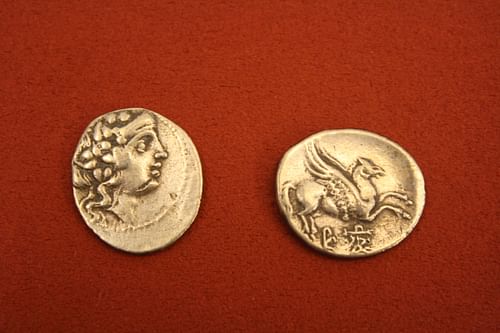
Hellenistic & Roman Periods
In the 4th century BCE Corcyra became more involved in regional politics, contributing two ships from her fleet towards Timoleon's expedition against Syracuse in 344 BCE and aiding the Athenians in their attempts to block Macedonia from operating in the Adriatic. Alexander's successors fought for control of the island following the break-up of the Macedonian empire and it was later occupied by Agathocles, tyrant of Syracuse. The Illyrians captured the island in 229 BCE but following intervention from Rome, the island became an important naval base for the next half century, governed by a Rome-nominated prefect. In 148 BCE the island was put under the jurisdiction of the province of Macedonia.
In the 1st century BCE the island backed two losers in succession: Pompey against Julius Caesar and Mark Antony against Octavian, the latter establishing a naval base on Corcyra in 31 BCE. The island was, however, given back some degree of independence under Emperor Claudius in the 1st century CE.
Archaeology
The island has several archaeological sites dating from the 7th and 6th centuries BCE on the Palaeopolis peninsula. Indicating the island's status as an important religious sanctuary there were several major temples, one of which was dedicated to Apollo, another to Poseidon and two more to Artemis - of which only the foundations and fragmentary pieces remain.
The famous Doric temple of Artemis, dated to c. 585 BCE, originally had 8x17 exterior columns and a 3-aisled cella, pronaos and opisthodomos with a clay tile roof, replaced with marble in 535-525 BCE. It is the earliest temple in Greece to incorporate major stone decorative sculpture. Large pieces of the west pediment survive and depict the mythical Gorgon Medusa flanked by panthers, illustrating her role as Potnia Theron, Mistress of Animals, an epithet often attributed to Artemis. Also depicted are Medusa's offspring Chrysaor (Golden-Sword) and the flying horse Pegasus, who also often appeared on the coins of ancient Corcyra. Other archaeological remains on Corfu include parts of the ancient city walls and, from the Roman period, shipyards, harbour installations, workshops and a paved agora.
